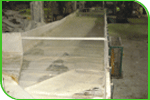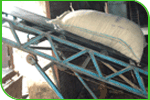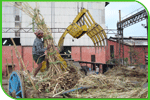Sugarcane is broadly classified into three varieties early, mid and late. Cane is sowed during October to March every year. The first seed growth is known as the plant and subsequent growth after harvesting from the stem is known as Ratoon. The early variety has more sugar content than the general variety.
Every farmer within the command area of the Mill is provided with a calendar, which tells him when he can expect a Mill Supply Ticket (cutting order), against which he will deliver the sugarcane.
He then harvests the cane and transports it either in a bullock cart, tractor, trolley or truck to the mill.

Cane is weighed and unloaded into cane carriers. It is then prepared for milling. Sugarcane juice is then extracted by pressing the prepared cane through mills.
Extracted juice mixed with water is weighed and sent to the boiling house for further processing. Residual bagasse is sent to boilers for use as fuel for steam generation
This juice is heated and then treated with milk of lime and sulphur dioxide. The treated juice is then further heated and sent to clarifiers for continuous settling. The settled mud is filtered by vacuum filters and filtered juice is returned to be further processed while the Oliver cake is sent out.
The clear juice is evaporated to a syrup stage, bleached by sulphur dioxide and then sent to vacuum pans for further concentration and sugar grain formation. Crystals are developed to a desired size and the crystallized mass is then dropped in the crystallizers to exhaust the mother liquor of its sugar as much as possible. This is then centrifuged for separating the crystals from molasses. The molasses is re-boiled for further crystallization

Thus, the original syrup is desugarised progressively (normally three times) till finally, a viscous liquid is obtained from which sugar can no longer be recovered economically. This liquid, which is called final molasses, is sent to the distillery for making alcohol.
The sugar thus is separated from molasses in the centrifuge is dried, bagged (50 Kg and 100 Kg), weighed and sent to storage houses.
Sugar is made in different sizes and accordingly classified into various grades i.e. large, medium and small.

This sugar is sparkling white, pure, manufactured without any toxic chemicals from the fresh canes. At Aska Sugar we producing M-30 and S-30 sugar as per standard fixed by government of India.
This Sugar is left after processing the sugar cane to remove the molasses and refine the white sugar. The colour is similar to light brown sugar but it's texture is grainier.
Sparkle White sugar in the brand name of ASKA SUGAR available in 1 kg poly packs.

